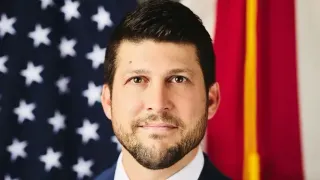November 25, 2022
World Cup Viewer's Guide: US Seeks Repeat of 1950 Upset
Jenna Fryer READ TIME: 5 MIN.
The first time the United States faced England at the World Cup, the hastily assembled American squad was a ragtag group that included a mailman, a grave digger, a dishwasher and a school teacher.
Few of the players had ever met before they headed to Brazil in 1950 to face powerhouse England, and the 1-0 upset victory by the United States is often likened to the 1980 "Miracle on Ice" win over the Soviet Union at the Lake Placid Olympics as being among the biggest moments in American sports history.
The disparity between the two national soccer teams isn't nearly as wide 72 years later as England and the United States get set to play Friday in Group B. In fact, United States midfielder Tyler Adams said he's more frightened of spiders than he is of facing England.
The Americans are the underdogs following their 1-1 draw with Wales, while England is coming off a 6-2 opening win over Iran.
"England are still a big team at the end of the day, but the intimidation factor? I wouldn't say there's many things out there that intimidate me, other than spiders," said Adams, who plays for Premier League club Leeds.
"It's fine for me, but obviously I've got to play against all those big players, so I've done it before. But we also want to show what we're capable of and that U.S. soccer is developing and growing in the right way."
But that 1950 victory for the Americans was a rare win against England, which has won eight of its 11 meetings against the United States. The upside? None of those victories were World Cup matches and the second meeting between the teams on soccer's biggest stage ended in a 1-1 draw in 2010.
United States midfielder Christian Pulisic doesn't want to hear about stats, rankings or predictions. The Americans failed to qualify for the 2018 World Cup and, following the opening draw, are tied with Wales with one point each in the fight to advance to the knockout stage.
England leads the group with three points. A win or draw on Friday would put the Americans in decent position to be one of the two teams to advance.
"We don't look at the odds and we're not at the World Cup just to make up the numbers," Pulisic said. "We go, we give it everything in every game we play, we make America proud. Wherever that takes us we have to wait and see."
INJURY CONCERNS
A win for England would put the Three Lions into the round of the 16 with one game still to play, but coach Gareth Southgate has cautioned against complacency after the opening rout of Iran.
England captain Harry Kane, the top scorer at the 2018 World Cup, injured his ankle against Iran and defender Harry Maguire left the game in the 70th minute with blurred vision. Kane trained with the team in recent days and is expected to play Friday, while Maguire indicated he'll play in what will be his 50th appearance for the national team.
Southgate told his team it needs to be even better against the United States than it was against Iran, and he thought the two late goals conceded proved England got sloppy at the end of that game.
"They're a top nation with a lot of top players who have played in the Premier League and who we've come up against," England goalkeeper Jordan Pickford said. "But it's about us as a squad being 100%. It's about us taking the result from Iran and going into the U.S. game positive."
BACK ON THE FIELD
Qatar returns to competition after becoming the first host nation in World Cup history to drop its first match, a 1-0 loss to Ecuador on the opening night of the tournament.
Qatar gets another chance for a victory against Senegal, which also lost its opener.
"There is a lot of room for improvement. Maybe the responsibility and nerves got the best of us," Qatar coach Felix Sanchez said. "We didn't start well. It was a terrible start."
Senegal is without Sadio Mane, the Bayern Munich forward who was ruled out of the tournament with a leg injury. Midfielder Cheikhou Kouyate is also expected to miss Friday's game with a hamstring injury.
Without Mane at the World Cup, Senegal lost to the Netherlands 2-0 and coach Aliou Cissé is demanding more from forwards Ismaila Sarr and Krépin Diatta.
"We needed to be more effective. Ismaila and Krepin are responsible there, but of course, the absence of Mane is a problem for us," Cisse said. "Our attackers are good and we know what they are capable of. We need to work on it, with Ismaila and the others. We expect a lot from him and Krepin."
WALES-IRAN
Gareth Bale scored a late goal from a penalty kick to help Wales draw with the United States in its opening match and was thrilled to be given the starring role in his World Cup debut.
The 33-year-old Bale, who plays for the Los Angeles Galaxy in the MLS, had zero hesitation when called on to take the penalty.
"It was always going to be me. No doubts," Bale said. "I feel like I had to step up and I was happy to do so."
The Asian team will be missing goalkeeper Ali Beiranvand, who is out with an injury. He was cleared to continue by Iran's medical staff after a collision with a teammate in the opening game but later collapsed on the field and was taken to a local hospital. Hossein Hosseini, the backup, should be tested by Bale.
Iran, which qualified for the last two World Cups, has never ever advanced to the knockout round.
NETHERLANDS-ECUADOR
Ecuador and the Netherlands both won their opening matches and their game Friday will pit striker Enner Valencia against forward Memphis Depay.
Valencia scored both of Ecuador's goals in the 2-0 win over Qatar before leaving with a sore knee but is set to play Friday.
"Enner will play against the Netherlands, there is no doubt about that," Ecuador coach Gustavo Alfaro said.
Depay returned from a hamstring injury to lead the Netherlands in its 2-0 win over Senegal. He came off the bench in that game but wants to start against Ecuador.
"He is a player who can make the difference," Netherlands coach Louis Van Gaal said. "He will want to play, but I have to assess his form."
A win for either team would likely guarantee advancement out of Group A. ___
AP World Cup coverage: https://apnews.com/hub/world-cup and https://twitter.com/AP_Sports






